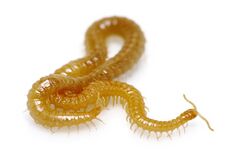Biology:Himantariidae
From HandWiki
Short description: Family of centipedes
| Himantariidae | |
|---|---|

| |
| Stigmatogaster subterranea | |
| Scientific classification | |
| Kingdom: | Animalia
|
| Phylum: | |
| Subphylum: | Myriapoda
|
| Class: | |
| Subclass: | Pleurostigmomorpha
|
| Order: | |
| Suborder: | |
| Superfamily: | |
| Family: | Himantariidae
|
Himantariidae is a monophyletic family of centipedes in the order Geophilomorpha and superfamily Himantarioidea,[1] found almost exclusively in the Northern Hemisphere.[2] The number of leg-bearing segments in this family varies within as well as among species and ranges from 47 to 181.[3] These centipedes are very elongated with a high mean number of trunk segments (often greater than 100) and great variability in this number within species.[4] The maximum number of legs recorded in this family (181 pairs) appears in the species Chomatobius bakeri.[5][6] The minimum number of legs recorded in this family (47 pairs) appears in the species Garriscaphus oreines,[7][8] This family contains these genera:
- Acrophilus
- Bothriogaster
- Californiphilus
- Causerium
- Chomatobius
- Diadenoschisma
- Geoballus
- Gosiphilus
- Gosothrix
- Haplophilus
- Himantariella
- Himantarium
- Meinertophilus
- Mesocanthus
- Nesoporogaster
- Nothobius
- Notiphilus
- Notobius
- Polyporogaster
- Pseudohimantarium
- Stigmatogaster
- Straberax
- Thracophilus
References
- ↑ Bonato, Lucio (2014). "Phylogeny of Geophilomorpha (Chilopoda) inferred from new morphological and molecular evidence". Cladistics. The International Journal of the Willi Hennig Society 30 (5): 485–507. doi:10.1111/cla.12060. PMID 34794246.
- ↑ R. E. Crabill (1969). "Tracheotaxy as a generic criterion in Himantariidae, with proposal of two new bothriogastrine genera (Chilopoda: Geophilomorpha)". Smithsonian Contributions to Zoology 12 (12): 1–9. doi:10.5479/si.00810282.12.
- ↑ Bonato, Lucio; Edgecombe, Gregory D.; Zapparoli, Marzio (2011). "Chilopoda – Taxonomic overview". in Minelli, Alessandro. The Myriapoda. Volume 1. Leiden: Brill. pp. 363–443. ISBN 978-90-04-18826-6. OCLC 812207443. https://www.worldcat.org/oclc/812207443.
- ↑ Minelli, Alessandro; Bortoletto, Stefano (1988-04-01). "Myriapod metamerism and arthropod segmentation". Biological Journal of the Linnean Society 33 (4): 323–343. doi:10.1111/j.1095-8312.1988.tb00448.x. ISSN 0024-4066. https://doi.org/10.1111/j.1095-8312.1988.tb00448.x.
- ↑ Chamberlin, R.V. (1912). "The Chilopoda of California. III.". Pomona College Journal of Entomology 4: 651–672 [672]. https://www.biodiversitylibrary.org/page/8204630#page/324/mode/1up.
- ↑ Bonato L.; Chagas Junior A. (2016). "Chomatobius bakeri (Chamberlin,1912)". ChiloBase 2.0: A World Catalogue of Centipedes (Chilopoda). Rosario Dioguardi and Giuseppe Cortese. https://chilobase.biologia.unipd.it/searches/result_species/3079. Retrieved 28 December 2023.
- ↑ Chamberlin, Ralph V. (1941-12-01). "New Genera and Species of North American Geophiloid Centipeds". Annals of the Entomological Society of America 34 (4): 773–790 [790]. doi:10.1093/aesa/34.4.773. ISSN 1938-2901. https://doi.org/10.1093/aesa/34.4.773.
- ↑ Bonato L.; Chagas Junior A. (2016). "Garriscaphus oreines Chamberlin, 1941". ChiloBase 2.0: A World Catalogue of Centipedes (Chilopoda). Rosario Dioguardi and Giuseppe Cortese. https://chilobase.biologia.unipd.it/searches/result_species/3824. Retrieved 24 February 2023.
Wikidata ☰ Q4040674 entry
 |

